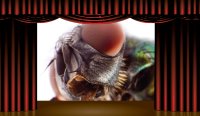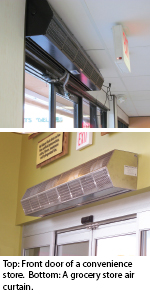 The air curtain is an ideal solution to the pest management industry’s ongoing response to commercial/industrial client requests for fewer chemicals and more environmentally sensitive methods of controlling flying insects in occupied spaces.
The air curtain is an ideal solution to the pest management industry’s ongoing response to commercial/industrial client requests for fewer chemicals and more environmentally sensitive methods of controlling flying insects in occupied spaces.
While insect light traps (ILT), glue boards, and electrocuting devices will always be irreplaceable reactive approaches after flying insects infiltrate a space, the air curtain is a proactive method that prevents airborne pests from entering in the first place.
It’s this premise that’s driving many pest control management companies, franchises, and chains to the trend of applying air curtains for chemical-free and effective flying insect control. Illustrating the pest management industry’s trend toward air curtains, the feature article, “Green Pest Management — A Day Without Pesticides” in the March 2014 issue of PCT mentions air curtains as a chemical-free solution to flying insect control. Author Kathy Heinsohn, Ph.D., BCE, a technical and training entomologist with American Pest, Fulton, Md., likens air curtain used to “thinking outside the box.”
What Are They?
Air curtains are not a new technology. For decades, air curtains (sometimes referred to as air doors) have been a source of saving energy, preventing flying insect ingress, and improving employee air comfort at open doorways in industrial and agricultural applications.
Simply, an air curtain is a metal box with blowers, motors and an air discharge nozzle with directional louvers. What’s not simple is the effectiveness of the technology. Air curtain technology draws interior air from the facility and discharges it through field-adjustable (+/- 20-degree) linear nozzles that “seal” the doorway with a non-turbulent air stream that meets the floor approximately at the threshold of the door opening. Because an air curtain discharges air at velocities generally in the range from 1,000 to 3,000 feet/minute, it separates the indoor from the outdoor environment and prevents outside air, airborne dust and particularly flying insect infiltration. Air curtains are typically activated by a limit switch or a smart control that can be programmed for a variety of door opening and closing functions, as well as supplemental spot heating from optional on-board electric, steam or hot water coils.
In the last 10 years, air curtains have grown past industrial applications, mainly due to high-end finishes and fashionable commercial designs, such as the new in-ceiling mount models that appear like a ceiling grille over the doorway. Consequently, retailers, restaurateurs, and hoteliers are adding the technology to their establishments. Restaurants, in particular, are adding them for flying insect protection at the back shipping door, front door, and the drive-thru window.
Air curtains don’t require maintenance other than a periodic air filter change and check-up to assure the air flow is sufficiently sealing the doorway’s perimeter and properly reaching the threshold.
Insect Control in the Field
Possibly one of the pest control industry’s leading air curtain advocates is Dan Clark, president of Flytech Supply, Moreno Valley, Calif., who has both retail/wholesale pest control clients. Clark sells air curtains to customers, typically combining them with ILT devices. Clark recalled one warehouse that was infested with thousands of flies. Fecal matter littered interior table and floor surfaces. Forty ILTs and an arsenal of electocuters were killing flies, but those products were overwhelmed by the steady supply of flies via unobstructed, high-traffic pedestrian doors. There was no solution other than air curtains, according to Clark. He sold the customer three air curtains, one 42-inch model and two 36-inch models, that protected the doorway to an outdoor dining area and the warehouse’s double glass door employee entry. The air curtain models, which were tested and certified by the National Sanitation Foundation (NSF), Washington, D.C., and the Air Movement and Control Association-International (AMCA), Arlington Heights, Ill., reduced fly infiltration to less than .01 percent and allowed Clark to reduce the ILTs from forty to four for any remaining flies. The AMCA certification is particularly important, Clark says, because it assures the manufacturer’s equipment claims aren’t inflated, have been tested under lab conditions and performs to advertised specifications, which guarantees the air curtain’s efficacy.
How PMPs Use Air Curtains
Insect control companies that sell air curtains to their customers can either install them in-house for increased profit margins or subcontract the installation. Some pest control companies have employees capable of hanging air curtains from ceilings or mounting them on walls, which typically requires only conventional tools and hardware, such as threaded rod and wall brackets. The electrical service should be run by licensed electricians or contractors.
Probably the greatest air curtain growth market for pest control companies is the food-service business. For example, the California Health and Safety Code has mandated air curtains for more than 15 years on back doors and receiving doors of all food-service establishments, which would include restaurants, convenience stores, hotels and other establishments that prepare and serve food. Other states are following California’s lead in this type of health code criteria.
USDA is another government agency that recommends air curtains for meat and poultry establishments in their guidebook (The Federal Register Volume 62, Number 164, Chapter 13, August 23, 1997).
Drive-Thru Windows
Since flies don’t know the back door from the front door, food-service establishments with indoor fly infiltration histories should consider air curtains for customer entrances and drive-thru windows, as well as back-end shipping doors.
Flytech recommends air curtains on drive-thru windows, the latter which now constitutes more than 50 percent of the quick-serve restaurant business, according to the National Restaurant Association (NRA). Dan Clark of Flytech recalls a taco restaurant client located near an animal stockyard area where flies literally swarmed outside the restaurant and gained indoor access through the drive-thru window. A drive through unit air curtain, which is designed for the specific length and height of the service window, added to the flying insect prevention strategy.
 Another trend is the use of air curtains at the food-service windows of open-air sports stadiums and complexes. McKechnie Field, the Bradenton, Fla.-based spring training home of the Pittsburgh Pirates Major League Baseball team, recently installed more than 20 air curtains at the food-service point-of-sale windows to comply with local health codes and to promote visibility of interior-mounted menu boards. Another stadium, the new $18 million Pensacola Bay Front Stadium in Florida’s panhandle, is using eight air curtains to prevent flying insects in two separate 3,600-square-foot food-preparation and service concession areas. At this facility, which is the home of the Cincinnati Reds’ new AA Southern League affiliate, the Pensacola Blue Wahoos, stadium officials also have discovered the stadium’s air curtains have discouraged seagulls from entering the food-service areas from nearby beaches.
Another trend is the use of air curtains at the food-service windows of open-air sports stadiums and complexes. McKechnie Field, the Bradenton, Fla.-based spring training home of the Pittsburgh Pirates Major League Baseball team, recently installed more than 20 air curtains at the food-service point-of-sale windows to comply with local health codes and to promote visibility of interior-mounted menu boards. Another stadium, the new $18 million Pensacola Bay Front Stadium in Florida’s panhandle, is using eight air curtains to prevent flying insects in two separate 3,600-square-foot food-preparation and service concession areas. At this facility, which is the home of the Cincinnati Reds’ new AA Southern League affiliate, the Pensacola Blue Wahoos, stadium officials also have discovered the stadium’s air curtains have discouraged seagulls from entering the food-service areas from nearby beaches.
Besides restaurants, air curtains are also a good flying insect prevention application for the shipping doorways of food-processing and food-manufacturing industries. These industries however, may require hazardous location (HL) models, because of their inherent presence of grain and flour dust, which in turn can ignite and cause explosions. The air curtain industry has responded to these applications with HL models featuring explosion-proof motors, spark-resistant fans, HL-rated electrical components and construction, and other precautions required by ANSI/NFPA-70 National Electrical Code (NEC) regulations.
Final Thoughts.
While a pest management company’s main goal is to prevent flying insects, clients likely will enjoy the added benefit from air curtains’ energy conservation. Air curtains separate indoor from outdoor environments, therefore there’s a significant energy savings depending upon the indoor and outdoor air temperature differential and the number of daily door cycles. An air curtain might be irreplaceable for a client in terms of pest control, but the energy savings will deliver a payback that will pay back the equipment cost in two years or less.
Environmental concerns with pesticides likely will continue to increase in the future. However, pest management firms can prepare now by offering their clients chemical-free insect control options, such as air curtains.
The author is a sales manager at Berner International. He is a 39-year veteran of the food-service industry and holds a degree in business administration from Penn State University. Berner International is a 58-year-old company and an innovator of air curtain technology that offers air curtain sales and application assistance. Learn more at www.berner.com.
